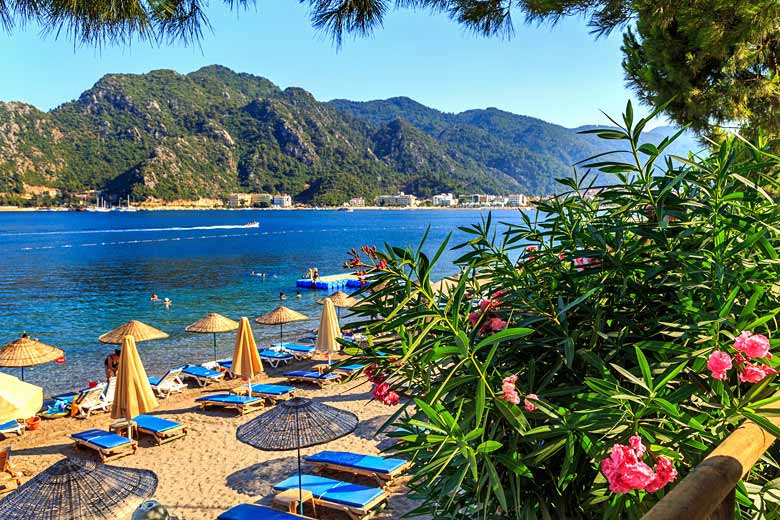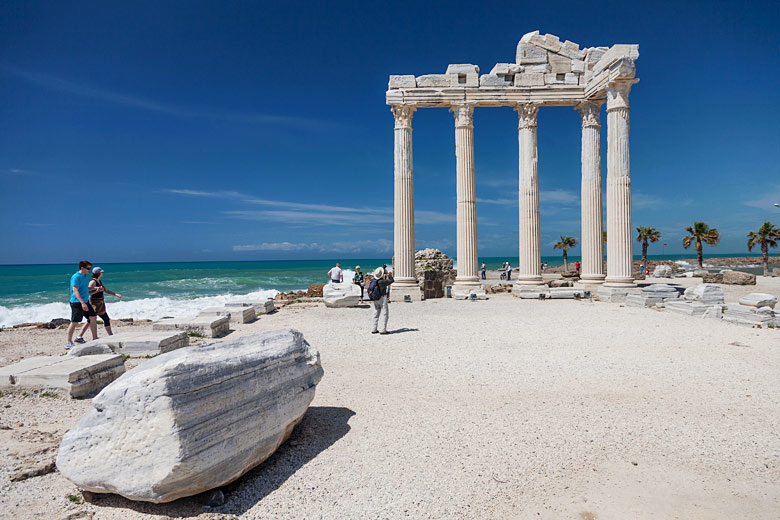- Book online with TUI & save up to 7% on holidays
- FREE child places available for select holidays
- Pay £0 deposits with direct debit & spread the cost
Turkey weather by month
Check out Turkey weather averages by month. Compare detailed monthly climate statistics including temperature, rainfall and sunshine figures.
| Jan | Feb | Mar | Apr | May | Jun | Jul | Aug | Sep | Oct | Nov | Dec | |
|---|---|---|---|---|---|---|---|---|---|---|---|---|
| Maximum daytime temperature °F | ||||||||||||
| Hours of sunshine (daily) | ||||||||||||
| Days with some rainfall | ||||||||||||
| Sea temperature °F |
More about Turkey
Turkey by month
Jan Feb Mar Apr May Jun Jul Aug Sep Oct Nov Dec
Recommended for Turkey
The climate guide for Turkey (Istanbul) shows long term monthly weather averages processed from data supplied by CRU (University of East Anglia), the Met Office & the Netherlands Meteorological Institute. Find out more about our data sources.
Top Turkey destinations
Below are average maximum temperatures at popular countries, regions and places in Turkey for next month - October. Select a destination to see the climate guide for all months of the year.
- Antalya Coast
- Belek
- Lara Beach
- Dalaman & Marmaris Coast
- Dalyan
- Olu Deniz
- Ovacik
- Alanya
- Bodrum & Izmir Coast
- Gumbet
- Kalkan
- Istanbul
All Turkey regions
All Turkey destinations
- Adana
- Akyaka, Bodrum & Izmir
- Akyarlar, Bodrum & Izmir
- Alanya, Antalya Coast
- Altinkum, Bodrum & Izmir
- Amasra
- Ankara
- Antalya, Antalya Coast
- Ayder
- Aydin, Bodrum & Izmir
- Beldibi, Antalya Coast
- Belek, Antalya Coast
- Bitez, Bodrum & Izmir
- Bodrum, Bodrum & Izmir
- Bursa
- Calis Beach, Dalaman & Marmaris
- Camyuva, Antalya Coast
- Canakkale
- Cesme, Bodrum & Izmir
- Colakli, Antalya Coast
- Dalaman, Dalaman & Marmaris
- Dalyan, Dalaman & Marmaris
- Datca, Dalaman & Marmaris
- Denizyaka, Antalya Coast
- Derekoy, Bodrum & Izmir
- Diyarbakir
- Dogubayazit
- Erzurum
- Fethiye, Dalaman & Marmaris
- Finike, Antalya Coast
- Gocek, Dalaman & Marmaris
- Gokcebel, Bodrum & Izmir
- Gokova, Bodrum & Izmir
- Goreme
- Gulluk, Bodrum & Izmir
- Gumbet, Bodrum & Izmir
- Gumusluk, Bodrum & Izmir
- Gundogan, Bodrum & Izmir
- Hisaronu, Dalaman & Marmaris
- Icmeler, Dalaman & Marmaris
- Incekum, Antalya Coast
- Istanbul
- Izmir, Bodrum & Izmir
- Kadikalesi, Bodrum & Izmir
- Kahta
- Kalkan, Dalaman & Marmaris
- Kars
- Kas, Dalaman & Marmaris
- Kayseri
- Kemer, Antalya Coast
- Kiris, Antalya Coast
- Konacik, Bodrum & Izmir
- Konakli, Antalya Coast
- Konya
- Kumkoy, Antalya Coast
- Kusadasi, Bodrum & Izmir
- Lara Beach, Antalya Coast
- Manavgat, Antalya Coast
- Marmaris, Dalaman & Marmaris
- Mazi, Bodrum & Izmir
- Mugla, Bodrum & Izmir
- Nevsehir
- Olu Deniz, Dalaman & Marmaris
- Ortakent, Bodrum & Izmir
- Ovacik, Dalaman & Marmaris
- Ozdere, Bodrum & Izmir
- Pamukkale
- Rize
- Samsun
- Sanliurfa
- Sarigerme, Dalaman & Marmaris
- Side, Antalya Coast
- Sinop
- Sivas
- Tekirova, Antalya Coast
- Torba, Bodrum & Izmir
- Trabzon
- Turgutreis, Bodrum & Izmir
- Turkbuku, Bodrum & Izmir
- Turunc, Dalaman & Marmaris
- Urgup
- Uzumlu, Dalaman & Marmaris
- Van
- Yaliciflik, Bodrum & Izmir
- Yalikavak, Bodrum & Izmir
- Yusufeli
Metric (°C) | Imperial (°F)
Turkey climate overview
Turkey lies at the eastern end of the Mediterranean, and the country's architecture, culture, and atmosphere are inevitably a fusion of western and eastern influences. A mixture of manufacturing and agriculture form the basis of the country's economy while tourism is a key source of foreign exchange.
Eastern Turkey is dominated by high mountains that peak along the Iranian border. Most famous of these is the majestic dormant volcano of Mount Ararat, the biblical resting place of Noah's Ark. The harsh landscape in the east has a harsh climate to match with bitterly cold and snowy winters. Summer temperatures are comfortable but even then, there is plenty of cloud and rain towards the Black Sea coast at Rize and Trabzon.
The vast Anatolian Plateau accounts for much of central Turkey; it is less mountainous than the east but still fairly elevated. The landscape is bare in many parts suitable only for grazing but in the more fertile valleys such as at Sivas wheat and barley is grown. Spring thunderstorms precede a dry and warm summer, with cool nights. Winters tend to be wet and cold with a dusting of snow.
The extensive Mediterranean shoreline is known for its impressive coastal ruins and outstanding natural beauty. Secluded bays like Olu Deniz can be found along the Turquoise Coast in the east, while to the west, the wild coastal scenery becomes more rugged with deserted beaches to the east of Alanya. The sub-tropical climate has a dry and warm summer season with very little cloud. Winters are cool, wet, and often windy.
Turkey's Black Sea coast is plagued by a cool, wet, and cloudy climate for much of the year, with conditions improving only slightly during the summer. The mountainous backdrop is rugged and craggy with understandably lush vegetation.
Much of Turkey lies on active fault lines and therefore the risk of earthquakes is high almost everywhere.
More about Turkey
Compare Turkey with the USA
Below the Turkey chart shows average maximum daytime temperature for Turkey (Istanbul) and the USA (Washington).
Maximum daytime temperature (°F)
Metric (°C) | Imperial (°F)
Compare more Turkey weather >>
Be inspired
Get your weekly fix of holiday inspiration from some of the world's best travel writers plus save on your next trip with the latest exclusive offers
We promise not to share your details
Related posts
Popular travel offers
Explore holidays in the sun for less
- Beach holidays
- Family holidays
- City breaks
- Summer holidays
- Winter sun holidays
- Holiday offers
- Top travel brands
- Airlines & flights
- Discount hotels
- Airport parking deals
- TUI
- Jet2holidays
- easyJet holidays
- Love Holidays
- British Airways
Airport parking
- Manchester Airport
- Stansted Airport
- Bristol Airport
- Luton Airport
- Birmingham Airport
- Edinburgh Airport
- Gatwick Airport
- Glasgow Airport
- Newcastle Airport
Airport lounges
- Manchester Airport
- Birmingham Airport
- Bristol Airport
- Edinburgh Airport
- Glasgow Airport
- Heathrow Airport
- Newcastle Airport
- Stansted Airport
- Gatwick Airport






































 TUI deal finder
TUI deal finder




